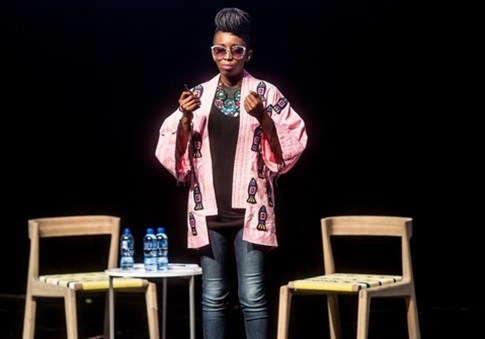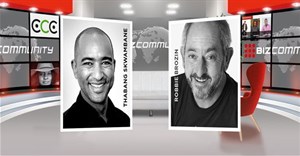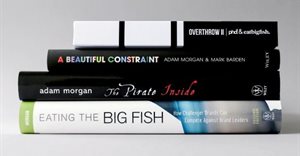Trending
[Design Indaba 2015] Conference highlights - Day two
1. Robbie Brozin
The second day of Design Indaba 2015 kicked off with MC Michelle Constant in conversation with Robbie Brozin of Nando's. He spoke through the brand's advertising history, explaining that the fact "they're totally un-PC and full of humour," is how they made a name. As they had no resources at the start, Brozin said it's proof that "We could do a lot with a little... we couldn't afford actors so we used chickens, they didn't talk back:
"I wish I could go back and say it was about a grand strategy, but it wasn't. We're a people-centric business," he added, sharing a common sentiment that at the end of the day you don't want it to feel like work, "you want to work with your mates and feel you've made an impact with something you're passionate about". Constant said that from the vintage Nando's ads that captured our imagination to all the more controversial ones such as the Great Dictator ad, they've clearly learned you need a good understanding of your market for the humour to translate. At the end of the day we all want to have fun and make money, but Brozin aims to do so by also changing the way the world thinks about chicken. Now they're taking that philosophy even further afield by shifting emphasis from chicken on the table to art on the wall and finally a surprise announcement that Nando's will be bettering design by connecting the dots to create energy for young designers that the "peri peri hot design aesthetic" will be shared around the world.
Brozin closed by stating that from the first time he met Indaba organiser Ravi Naidoo, something clicked and they've been friends for 15 years. Brozin hopes the rest of South Africa will stand up and admit we are world class, much like Naidoo has done with Design Indaba over the years.
Robbie Brozin, founder @NandosSA - "Do something that your passionate about, life's too short." #DesignIndaba pic.twitter.com/NOfI6wf9pY
- Chris Rawlinson (@ChrisRawlinson) February 26, 2015
Kane is a Senegalese designer who stopped and asked herself what she is doing and why, and was pleased to find she was telling stories and expressing her inner truth. She took a year off to reconnect with fashion through Le Petit Pierres, a collective of fashion activists that holds fashion street shows, creating bridges between communities where separation is often rife. Kane finds it important to have a foot in countries across the globe while also doing what you can to boost your own country through your work. Based on this new-found philosophy, the clothes she made in a small atelier in Dakar were soon being featured in overseas magazines, which she says shows you really can do anything anywhere. "Dream now, it's an order," she said in closing, leaving us to watch Inner cruise, the video she styled, directed by Tom Escarmelle. It's embedded below to give you a taste:
3. Omar Victor Diop
Also hailing from Senegal, Diop loves working with Kane and says the country has always been a gateway where cultures have met and merged, "blending traditional fabric with the utmost of modernity". He says he photographs the stylistic evolution, and is the sixth child and first artist in 20 generations of family. He used to watch Soul Train growing up and loves Latin music as "it's not black or white, it's black and white." Diop then spoke of the [re]-mixing Hollywood series he collaborated on in 2013, explaining that when you're a kid and you watch a movie like James Bond or The Matrix, you don't care if the main character is black or white, old or young, and whether the movie was filmed in a Hollywood studio or not. While the series has been applauded for paying homage to much-loved movies, some took offense at what they called "African artists trying to paint Hollywood black". Luckily, Diop says hitting a nerve in this fashion is a good thing as we need to look beyond those boundaries others have painted. "We still have a lot of work to do in this business of working together as human beings, but history and the future are better if we share them - and it's easier if you have fun."
4. Santiago Cirugeda
The Spanish designer can speak in English but explained he was more comfortable speaking in Spanish with a translator giving each sentence to us in English - along with the appropriate hand gestures. Cirugeda's work in the realm of architecture means he often proposes solutions in the city to problems like empty spaces that could be better used. All of his projects are born from a need to connect and the desire for activism that always produces change in society. Cirugeda got applause for stating that as an architect he does his best work if he never thinks of the client, when he rather approaches a project as though the client doesn't exist as it's all about the end product based on the use of urban recipes.
"architecture in santiago is interesting. but ugly.
who doesn't have an ugly friend?"
santiago cirugeda
#DesignIndaba2015 #thursday
- dominique whelan (@BADbuyadonkey) February 27, 20155. Shubhankar Ray
With a 20-year career of reinventing fashion and lifestyle brands, one of Ray's highlights was getting actor Dennis Hopper to read poetry at a launch for G-Star. He presented the highlights of his high-profile work at Design Indaba 11 years ago so instead chose to present his side project - a book titled Molecular Brand Chemistry. Ray says context is what gives advertising its power, so you have to tap into your brand's DNA to make sure you understand it. Especially as most of the 20 most powerful brands of today didn't really exist 20 years ago, and the fact that media fragmentation means you can find almost anything online and the phone is no longer just a phone, it's your alter ego, so you have to get your brand to resonate with your consumers. Advertisers need to appeal to that and realise we now live in a blurred society with few real boundaries. That's partly why being contradictory worked for the Camper shoe brand - "If Nike said run, we said walk. If they said air, we said earth," explains Ray. He feels capitalism has gone wrong not because business is bad but because there's not enough education for consumers. That's why he's teamed up with names that mean something to consumers, like Pharrel Williams, in the RAW for the Oceans animation embedded below - because "the true heroes are actually acting to do something to clear the oceans".
6. Dominic Wilcox
Wilcox announced this was his first time in South Africa, and spoke of how there are so many ways to approach and find ideas and reach the magical place where they exist. He talked us through his process, which is mainly through a sketch pad and thinking through common problems that seemingly have no solution. Wilcox said that thinking things through means you often find surprises you wouldn't have otherwise stumbled upon. Looking at something more closely also helps with creativity, as there are hundreds of ideas just waiting to be found in everything around us. To prove his mettle Wilcox then showed us some of the ideas he's published to his blog, Variationsonnormal. The audience was enchanted by his ideas and by his acknowledgement that he treats playfulness deadly seriously as it's "the most important way of sourcing new ideas". He also challenges himself to be more creative, such as with his speed creating of 30 things in 30 days, and his 'Moments in time' watch sculpture and GPS shoes project, in collaboration with Dzine.com.
Watch Sculptures: Moments in Time by @dominicwilcox at #DesignIndaba http://t.co/KSrQ6etBcj pic.twitter.com/r2NYXYYsSW
- Michael Bierut (@michaelbierut) February 26, 20157. Roy Choi
Dubbed the 'godfather of the food truck movement', Choi lives in a world where the unbelievable turns into the believable, and the unrealistic into the realistic. He says in many cases you don't simply wake up a revolutionary, it comes to you by chance. As a chef he studied and practiced his craft and did the best he could. Like South Africa, Choi said Los Angeles is one of the most stereotyped cities in the world, but few acknowledge that behind it is culture, even if it is subversive. You have the stereotype of Hollywood, but behind the rolling cameras are thousands of designers and there's so much freshness with so many immigrants coming through that there's no real cemented ideals of history - "people just arrive". Choi used this to get members of his own kitchen staff to ask him a question in video format, which he then answered for the audience. He said the early days were beautiful but they had no money, they simply started the food truck "on a foggy night in the witching hour", and the process eventually became a scavenger hunt of sorts through using Twitter in the very early days when there was what he called "a collective intelligence going on, as we were all humans in that city in that time... It's like we'd been ready to communicate in that way all along, and when the Twitter app surfaced, we suddenly knew what to do." Choi said he's often criticised for being too idealistic but he says he speaks and thinks in hyperbole because that's how he sees it and dreams it, but as his physical life isn't there yet, tries to pull his dream world into reality - and to be fair, that's what we all do, as creatives.
8. Stefano Giovannoni
The Italian designer from Alessi spoke of early design style symbols from the 1980s, such as Swatch watches - they showed not that you were rich, but that you were trendy. Alessi best-sellers at the time were kettles and lemon juicers, then he struck gold in deciding to "cut out the shape of a little man" in the border of a steel plate, which went on to become one of Alessi's most iconic designs.
Designer Stefano Giovannoni showing us some of his design work for Alessi http://t.co/ueCxNGmk7r #DesignIndaba pic.twitter.com/DuXKsCejfk
- Ogilvy Cape Town (@OgilvyCT) February 26, 20159. Rosita Missoni
Standing ovation to welcome @Missoni founder, Rosita Missoni at #DesignIndaba @designindaba pic.twitter.com/uLDQHrPfBG
- Ogilvy South Africa (@OgilvySA) February 26, 2015She taught the family about the nature around them as though it was a beautiful game and source of inspiration. Rosita then thanked Teresa and said she was born in 1931 and educated in Italy - it was during a day at the Olympics in Wembley in 1948 that she saw her then-future husband for the first time, competing in the hurdles. "I was 16, I thought he was 21, but he was 27 and already had some grey hair, so I thought he was out of my league", she confessed. But she was wrong - "soon we were married, and he had started a knitting job with friends in a place where it was easier to make a sheep than to make a sweater." Describing her career, Missoni said: "We were the ones who made stripes, zigzags, prints and patterns. It's always a challenge to keep going but this job keeps me going with open eyes and it's been a joy to have the life I've lived and to enjoy such a wonderful job."
A thoroughly inspiring day and the perfect presentation 'filling' of the conference sandwich.




















